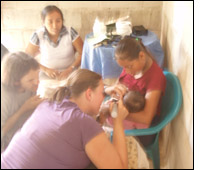Rebecca Eleck, MD
Guatemala: June 2009

As a family medicine resident, about 400 patients call me their doctor. During office visits, I can generally figure out what to do, whether it be
searching Up-To-Date, consulting a textbook, asking a faculty member or referring to a specialist. But practicing abroad is far different than in the US.
How much and yet how little of my knowledge carries over to the international arena continues to amaze me. Initially, it is surprising how much the clinic
in Las Cruces looks like my own. Patients come in for colds, fevers, coughs, headaches, back pain, dizziness, prenatal care, unexpected positive pregnancy
tests, birth control, mental health concerns, etc. These patients are my cross-cultural bridge. I am comfortable answering their questions, examining
them, speaking with authority, and finding reasonable treatment plans.
As the day goes on, and the clinic line grows, the familiar cases seem fewer, and my patients remind me how much I have yet to learn. After seeing a child
with fevers, I need someone to show me how to do a blood smear. At Middlesex Hospital, we generally send our malaria smears to the lab, but now I find
myself looking at a book and squinting into the microscope for little bugs� BINGO! A diagnosis. Then someone comes in with parasites. The book said to
treat with an anti-parasitic medicine, but my local colleagues have explained to me that if children have symptomatic parasites, they need to be treated
with a medicine to paralyze the worms first, otherwise the treatment can make the worms "angry." More than one child has died of suffocation with worms
crawling out their mouth and nose. Yikes! The next patient has managed to skip the line, and he's holding a bloody towel on his hand. Machete wounds come
in frequently, but he sliced his index finger and went clear through the tendon. Knowing my skills, I defer to a local health promoter, who knows how to do
tendon repairs. I watch with awe as they use perfect sterile technique while sitting on a picnic table, utilizing the brilliant daylight. With the skill of
an orthopedic surgeon, the tendon is sewn and the wound is closed� they do this every day.